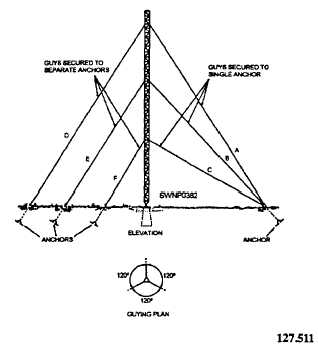stability As the mast approaches a vertical position, the permanent guys are fastened to the guy anchors installed before erection.
Hand Assembly
Erection, without a davit or gin pole, may be accomplished by the assembly of the individual members piece by piece, as the tower is erected. As assembler, you climb inside the tower and work with the lower half of your body inside the previously assembled construction. You then build the web of the tower section around you, as you progress upward. As each member is bolted in place, you should tighten all of the connections immediately so that at no time are you standing on or being supported by any loose member.
GUYING
Temporary guying of steel towers is always necessary where more than one tower section is erected. Under no circumstances should the tower be advanced more than two sections without guying. Permanent guys are to be installed before the temporary ones are removed.
Temporary Guying
Several materials, including stranded wire, wire rope, and fiber line, are all acceptable for temporary guying. New manila line is the most suitable because of its strength and ease of handling. The size of the guyed material required is determined by the height and weight of the structure to be guyed and by weather conditions at the installation site.
Secure the temporary guys to the permanent guy anchors to temporary type anchors or to any nearby structure that provides the required supporting strength. Leave the temporary guys in place until the structure is permanent y guyed and plumbed.
Permanent Guying
Antenna structures are permanently guyed with steel cables or fiber glass sections to pre-positioned anchors according to the installation plan.
Figure 8-37 shows two methods of guying triangular steel towers. Guys A, B, and C are secured to a single anchor, while guys D, E, and F are secured to individual anchors. Both arrangements are satisfactory. However, the anchor that terminates guys A, B, and C must be capable of withstanding much greater stresses than the individual guy anchor arrangement. Triangular tower guys are arranged so

Figure 8-37. - Tower-guying arrangements.
that three guys are spaced 120 degrees apart at each level of guying (fig. 8-36). Square towers require four guys spaced 90 degrees apart at each level of guying (fig. 8-37). Square towers require four guys spaced 90 degrees apart at each guying level. The following general elevation requirements apply to guy attachments for towers:
SINGLE-GUY LAYER The cable attachments are placed in position at approximately two thirds of the tower height.
TWO-GUY LAYERS. For towers with two-guy layers, cable attachments are placed in positions at approximately 30 and 80 percent of the tower height.
THREE-GUY LAYERS. For towers with three-guy layers, cable attachments are placed in positions at approximately 25,55, and 85 percent of the tower height.
Tower Guy Tension Setting guy tension and plumbing a tower are done at the same time and only when wind forces are light. Guy tension adjustment and tower plumbing are done as follows:
INITIAL TENSION. All of the guys should be adjusted gradually to the approximate tensions specified in the antenna installation details. If tensions are not specified, guy tension should be adjusted to 10 percent of the breaking strength of the strand of the
Continue Reading